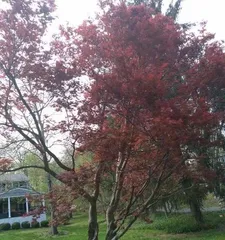The beauty, cold hardiness, and rich color variations of the maple tree have made it a beautiful symbol in people's hearts, and many people long to plant a maple tree in their hometown or courtyard. However, the growth environment and location of maple trees are different from other tree species, requiring us to conduct in-depth research and understanding. Next, this article will introduce in detail the suitable growth environment and location for maple trees.

I. A Sunny Environment
Maple trees prefer a sunny environment, which can promote their normal growth and reproduction. When choosing a location to plant a maple tree, try to avoid planting it in dark and damp places.
II. Loose, Well-Drained Soil
Maple trees have relatively high requirements for soil, preferring loose, well-drained soil such as sandy loam and loam, but they are not tolerant of saline-alkali or acidic soils. When planting a maple tree, suitable soil should be chosen to ensure its healthy growth.

III. A Suitable Mountainous Environment at Appropriate Altitude
Maple trees prefer to grow in mountainous environments at suitable altitudes, while in low-altitude plain areas, their growth rate will slow down. When choosing a location to plant a maple tree, the altitude should be taken into consideration.
IV. Regions with Pleasant Climates
Maple trees are a cold-tolerant species, but they also need a suitable climate to ensure normal growth. Generally, regions with temperatures above 5°C, sufficient rainfall, and moderate relative humidity are good places for maple trees to grow.
V. Avoid Excessive Human Interference
Maple trees grow slowly and are sensitive to the external environment, requiring full protection and care. When planting maple trees, excessive human interference and destruction, such as indiscriminate felling, should be avoided.

VI. Appropriate Fertilization
Appropriate fertilization can provide sufficient nutrients for maple trees, promoting their normal growth and reproduction. However, it should be noted that excessive fertilizer can harm the maple tree, so it must be applied on the basis of mastering the appropriate amount.
VII. Regular Pruning
Regular pruning can maintain the beautiful shape of the maple tree and promote its normal growth and reproduction. However, excessive pruning and damage to the maple tree's root system should be avoided.
VIII. Pay Attention to Pest and Disease Control
Maple trees are susceptible to pests and diseases such as aphids and borers, which require timely prevention, control, and elimination. At the same time, it is important not to use pesticides containing toxic chemicals to avoid harming the environment and human health.
IX. The Wonderful Changes in Maple Tree Growth
Maple trees exhibit different colors and morphological changes in different seasons and growth environments. For example, tender green in spring, deep green in summer, and red and yellow in autumn. This wonderful change is also one of the reasons why maple trees are loved by people.
X. The Cultural Significance of Maple Trees
Maple trees also have rich cultural significance, such as being regarded as a national treasure in Japan and the maple leaf pattern being printed on the Canadian flag. Meanwhile, in ancient China, the maple tree was also believed to have the qualities of a hermit and elegance.
XI. Suitable Environments and Locations for Different Types of Maple Trees
Different types of maple trees have different requirements for growth environments and locations. For example, North American maple and Japanese maple are suitable for growing in mountainous areas at an altitude of about 800 meters, while the large-leaved maple is suitable for growing in plain areas.
XII. Precautions for Planting Maple Trees
When planting maple trees, high-quality maple saplings should be selected, and appropriate pruning and watering should be carried out to ensure their normal growth and reproduction. At the same time, timely prevention and control of pests and diseases for the maple tree should also be noted.
XIII. The Harvest and Utilization of Maple Trees
Mature maple trees can provide rich resources and foods such as maple syrup and maple leaf tea. Maple wood, on the other hand, has characteristics such as high strength and durability, and can be used for making furniture, stairs, and other building materials.
XIV. The Protection and Sustainable Development of Maple Trees
The protection and sustainable development of maple tree resources are of great significance to the environment and society. We should strengthen the protection and management of maple tree resources and promote their sustainable development.
XV.
The maple tree is a beautiful and cold-tolerant species that likes sunny, well-drained soil and a suitable mountainous environment. When planting maple trees, it is necessary to pay attention to appropriate fertilization, regular pruning, and pest and disease control. At the same time, maple trees also have rich cultural significance and utilization value, and we need to strengthen their protection and sustainable development.